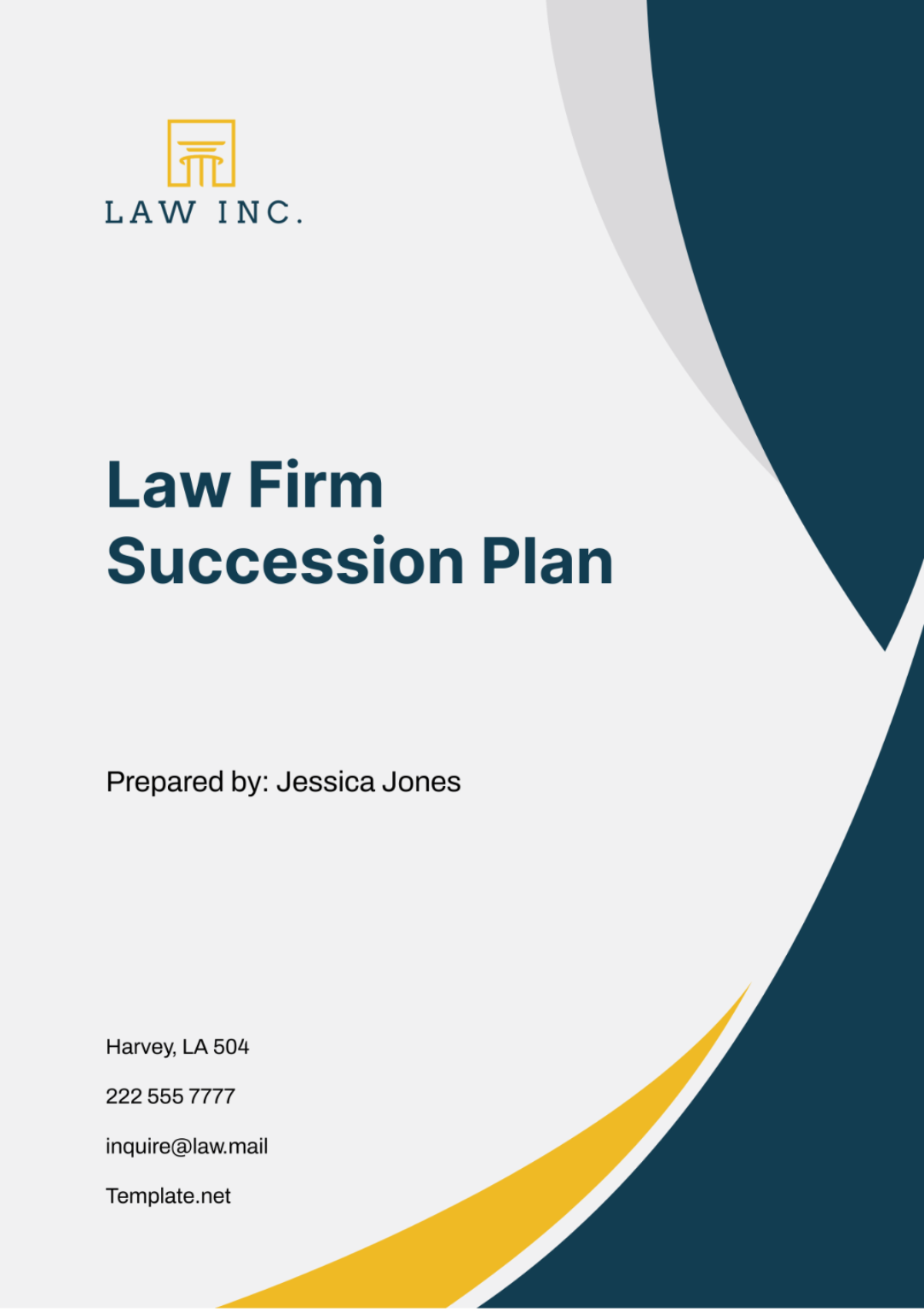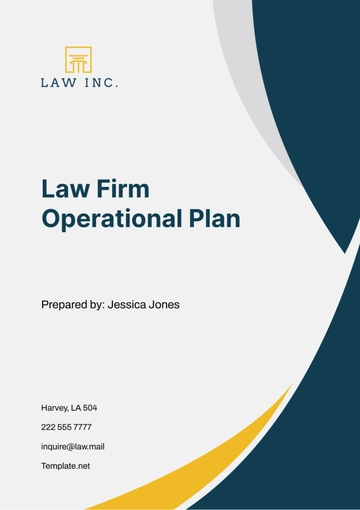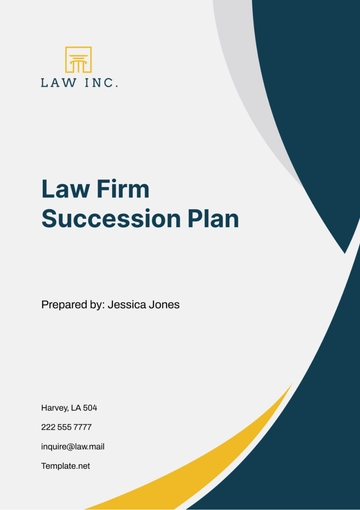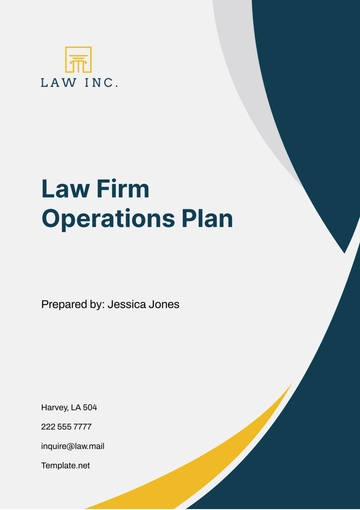Free Law Firm Succession Plan

I. Introduction and Overview
[Your Company Name] recognizes the critical importance of succession planning in ensuring the long-term success and sustainability of our firm. As we continue to grow and evolve, it is imperative that we have a clear strategy in place for identifying and developing future leaders who will carry forward our legacy of excellence in legal services. This succession plan outlines our commitment to cultivating talent, transferring knowledge, and seamlessly transitioning leadership roles within the firm.
II. Assessment and Identification
To assess the current state of leadership roles and identify potential successors, we will utilize the following criteria:
Criteria | Description |
|---|---|
Leadership Competencies | Evaluate leadership skills, including communication, decision-making, and strategic thinking. |
Legal Expertise | Assess legal knowledge and expertise in relevant practice areas. |
Client Relationships | Review client portfolios and relationships cultivated by potential successors. |
Succession Readiness | Consider readiness for leadership roles, including experience, tenure, and performance. |
Diversity and Inclusion | Ensure diversity and inclusion are considered in succession planning efforts. |
By evaluating potential successors against these criteria, we can identify individuals who possess the skills, experience, and potential to lead the firm effectively in the future.
III. Development and Training
[Your Company Name] is committed to investing in the growth and development of our future leaders. To prepare potential successors for their roles, we conduct the following development and training initiatives:
Mentorship Programs: Established mentorship programs pairing junior lawyers with experienced partners to provide guidance, support, and career development opportunities.
Leadership Workshops: Regular workshops focused on developing essential leadership skills, such as communication, decision-making, and conflict resolution.
Continuing Legal Education (CLE): Encouragement and financial support for ongoing professional development through participation in relevant CLE courses, seminars, and conferences.
Cross-Functional Experience: Opportunities for potential successors to gain exposure to different practice areas and functional areas within the firm to broaden their expertise and perspective.
Performance Feedback and Coaching: Regular performance reviews and coaching sessions to provide constructive feedback and support individual growth and development.
Succession Planning Retreats: Annual retreats bringing together current and potential leaders to discuss succession planning strategies, share insights, and foster collaboration.
External Leadership Programs: Sponsorship for participation in external leadership programs and executive education courses to further develop leadership capabilities.
IV. Knowledge Transfer and Transition
Effective knowledge transfer and transition of responsibilities are critical aspects of successful succession planning. [Your Company Name] is committed to facilitating a seamless transition of leadership by implementing the following comprehensive strategies:
Knowledge Documentation: Identification and documentation of critical knowledge, including precedents, client histories, and best practices, to ensure that essential information is captured and accessible to successors.
Formalized Training Programs: Development and implementation of formalized training programs to transfer specialized knowledge and skills from outgoing leaders to potential successors. These programs may include shadowing opportunities, on-the-job training, and structured learning sessions.
Client Relationship Transition Plans: Development of customized transition plans for client relationships managed by outgoing leaders. These plans outline key contacts, communication strategies, and transition milestones to ensure a smooth handover of client responsibilities to successors.
Mentorship and Coaching: Continued mentorship and coaching from outgoing leaders to potential successors to provide ongoing support, guidance, and feedback throughout the transition process.
Client Introductions and Meetings: Facilitation of introductions and joint meetings between outgoing leaders and their successors to transition client relationships and ensure continuity of service delivery.
Successor Readiness Assessments: Regular assessments of successor readiness to assume leadership responsibilities, including evaluations of skills, knowledge, and client management capabilities.
Client Communication and Relationship Management: Clear communication with clients regarding leadership transitions, including proactive outreach to address any concerns or questions and reassure clients of our continued commitment to their needs.
Post-Transition Support: Ongoing support and assistance for successors as they assume their new roles, including access to resources, mentorship, and guidance to help navigate potential challenges or uncertainties.
V. Financial and Legal Considerations
Succession planning involves various financial and legal considerations that must be addressed to ensure a smooth transition of leadership and ownership within the firm. [Your Company Name] is committed to managing these considerations effectively to minimize risks and facilitate a successful succession process. The key financial and legal considerations include:
Buyout Agreements: Development of buyout agreements for retiring partners or departing shareholders outlining the terms and conditions for the buyback of their equity interests in the firm. These agreements typically address valuation methodologies, payment terms, and other relevant provisions.
Equity Ownership Transition: Structuring the transition of equity ownership within the firm, including the sale or transfer of ownership interests to incoming partners or successors. This may involve legal agreements, such as partnership agreements or shareholder agreements, outlining the rights and obligations of equity owners.
Compensation Structures: Review and adjustment of compensation structures to accommodate changes in leadership roles and responsibilities. This may include establishing performance-based incentives, profit-sharing arrangements, and other compensation mechanisms to align with the firm's succession objectives.
Tax Planning: Consideration of tax implications associated with leadership transitions and ownership changes within the firm. This may involve consultation with tax advisors to develop tax-efficient strategies for structuring buyout agreements, equity transfers, and other financial transactions.
Insurance and Risk Management: Evaluation of insurance coverage and risk management strategies to mitigate potential liabilities associated with leadership transitions. This may include securing key person insurance, directors and officers (D&O) liability insurance, and other forms of coverage to protect the firm and its stakeholders.
Regulatory Compliance: Ensuring compliance with regulatory requirements governing leadership transitions and ownership changes within the legal profession. This may include adherence to state bar regulations, professional standards, and ethical guidelines related to partner retirements, firm mergers, or other succession events.
Client Fee Structures: Review and adjustment of client fee structures to reflect changes in leadership and service delivery models within the firm. This may involve communicating with clients regarding any modifications to billing rates, fee arrangements, or billing practices resulting from leadership transitions.
Succession Funding: Securing funding and financial resources to support the implementation of the succession plan, including financing options for buyout agreements, equity purchases, or other transition-related expenses.
VI. Communication and Transparency
Effective communication and transparency are essential pillars of successful succession planning. [Your Company Name] is committed to maintaining open and transparent communication with all stakeholders throughout the succession process. The key components of our communication and transparency strategy include:
Stakeholder Engagement: Engaging with all stakeholders, including partners, staff, clients, and external stakeholders, to solicit input, address concerns, and foster alignment around the succession plan's objectives and timelines.
Regular Updates and Progress Reports: Providing regular updates and progress reports on the status of the succession planning efforts, including milestones achieved, challenges encountered, and next steps. These updates may be communicated through firm-wide emails, newsletters, or town hall meetings.
Town Hall Meetings and Q&A Sessions: Hosting town hall meetings and Q&A sessions to provide a forum for stakeholders to ask questions, share feedback, and express concerns regarding the succession plan. These sessions will be facilitated by senior leadership to ensure transparency and accountability.
Individual and Team Meetings: Conducting individual and team meetings with key stakeholders, including outgoing leaders, potential successors, and client-facing teams, to discuss specific aspects of the succession plan and address any questions or concerns.
Client Communications: Proactively communicating with clients regarding leadership transitions, including introducing successors, addressing any potential impacts on client service, and reassuring clients of our continued commitment to their needs and interests.
Transparency in Decision-Making: Maintaining transparency in decision-making processes related to succession planning, including how potential successors are identified, evaluated, and selected for leadership roles within the firm.
Confidentiality and Privacy: Respecting the confidentiality and privacy of sensitive information related to succession planning, while also ensuring that stakeholders have access to the information they need to understand and support the process.
Feedback Mechanisms: Establishing feedback mechanisms, such as anonymous surveys or suggestion boxes, to gather input from stakeholders regarding their perceptions of the succession planning process and areas for improvement.
VII. Implementation Timeline
The following timeline outlines the key steps and milestones for executing the succession plan:
Phase | Activities | Timeline |
|---|---|---|
Preparation | Assess current leadership roles and potential successors | Month 1 - Month 2 |
Develop criteria for identifying successors | Month 2 | |
Establish communication plan for stakeholders | Month 2 | |
Development | Implement mentorship programs and leadership workshops | Months 3 - 6 |
Conduct training and development initiatives | Months 3 - 9 | |
Transition | Document critical knowledge and client relationships | Months 6 - 12 |
Develop transition plans for outgoing leaders | Months 6 - 12 | |
Facilitate client introductions and transition meetings | Months 9 - 12 | |
Monitoring | Monitor progress and adjust strategies as needed | Ongoing |
Conduct regular check-ins with stakeholders | Ongoing | |
Evaluation | Evaluate effectiveness of succession plan | Year 1 - Year 2 |
Gather feedback from stakeholders | Year 1 - Year 2 | |
Adjustment | Make adjustments to succession plan as necessary | Year 2 and beyond |
VIII. Conclusion and Commitment
In conclusion, the Law Firm Succession Plan for [Your Company Name] outlines our firm's commitment to preparing for the future and ensuring the continued success of our practice. By investing in the development of our people, facilitating the transfer of knowledge and leadership, and maintaining open communication throughout the process, we are confident in our ability to navigate leadership transitions effectively and sustain our legacy of excellence for years to come. We are committed to executing this plan with diligence and adaptability, and we look forward to the continued growth and success of our firm.
- 100% Customizable, free editor
- Access 1 Million+ Templates, photo’s & graphics
- Download or share as a template
- Click and replace photos, graphics, text, backgrounds
- Resize, crop, AI write & more
- Access advanced editor
Prepare for the future with Template.net's Law Firm Succession Plan Template. Editable in our AI Editor Tool, this customizable template provides a structured format for identifying key roles, potential successors, and strategies for smooth transitions in your law firm. Enhance continuity, mitigate risks, and ensure the long-term success of your firm!
You may also like
- Finance Plan
- Construction Plan
- Sales Plan
- Development Plan
- Career Plan
- Budget Plan
- HR Plan
- Education Plan
- Transition Plan
- Work Plan
- Training Plan
- Communication Plan
- Operation Plan
- Health And Safety Plan
- Strategy Plan
- Professional Development Plan
- Advertising Plan
- Risk Management Plan
- Restaurant Plan
- School Plan
- Nursing Home Patient Care Plan
- Nursing Care Plan
- Plan Event
- Startup Plan
- Social Media Plan
- Staffing Plan
- Annual Plan
- Content Plan
- Payment Plan
- Implementation Plan
- Hotel Plan
- Workout Plan
- Accounting Plan
- Campaign Plan
- Essay Plan
- 30 60 90 Day Plan
- Research Plan
- Recruitment Plan
- 90 Day Plan
- Quarterly Plan
- Emergency Plan
- 5 Year Plan
- Gym Plan
- Personal Plan
- IT and Software Plan
- Treatment Plan
- Real Estate Plan
- Law Firm Plan
- Healthcare Plan
- Improvement Plan
- Media Plan
- 5 Year Business Plan
- Learning Plan
- Marketing Campaign Plan
- Travel Agency Plan
- Cleaning Services Plan
- Interior Design Plan
- Performance Plan
- PR Plan
- Birth Plan
- Life Plan
- SEO Plan
- Disaster Recovery Plan
- Continuity Plan
- Launch Plan
- Legal Plan
- Behavior Plan
- Performance Improvement Plan
- Salon Plan
- Security Plan
- Security Management Plan
- Employee Development Plan
- Quality Plan
- Service Improvement Plan
- Growth Plan
- Incident Response Plan
- Basketball Plan
- Emergency Action Plan
- Product Launch Plan
- Spa Plan
- Employee Training Plan
- Data Analysis Plan
- Employee Action Plan
- Territory Plan
- Audit Plan
- Classroom Plan
- Activity Plan
- Parenting Plan
- Care Plan
- Project Execution Plan
- Exercise Plan
- Internship Plan
- Software Development Plan
- Continuous Improvement Plan
- Leave Plan
- 90 Day Sales Plan
- Advertising Agency Plan
- Employee Transition Plan
- Smart Action Plan
- Workplace Safety Plan
- Behavior Change Plan
- Contingency Plan
- Continuity of Operations Plan
- Health Plan
- Quality Control Plan
- Self Plan
- Sports Development Plan
- Change Management Plan
- Ecommerce Plan
- Personal Financial Plan
- Process Improvement Plan
- 30-60-90 Day Sales Plan
- Crisis Management Plan
- Engagement Plan
- Execution Plan
- Pandemic Plan
- Quality Assurance Plan
- Service Continuity Plan
- Agile Project Plan
- Fundraising Plan
- Job Transition Plan
- Asset Maintenance Plan
- Maintenance Plan
- Software Test Plan
- Staff Training and Development Plan
- 3 Year Plan
- Brand Activation Plan
- Release Plan
- Resource Plan
- Risk Mitigation Plan
- Teacher Plan
- 30 60 90 Day Plan for New Manager
- Food Safety Plan
- Food Truck Plan
- Hiring Plan
- Quality Management Plan
- Wellness Plan
- Behavior Intervention Plan
- Bonus Plan
- Investment Plan
- Maternity Leave Plan
- Pandemic Response Plan
- Succession Planning
- Coaching Plan
- Configuration Management Plan
- Remote Work Plan
- Self Care Plan
- Teaching Plan
- 100-Day Plan
- HACCP Plan
- Student Plan
- Sustainability Plan
- 30 60 90 Day Plan for Interview
- Access Plan
- Site Specific Safety Plan





























